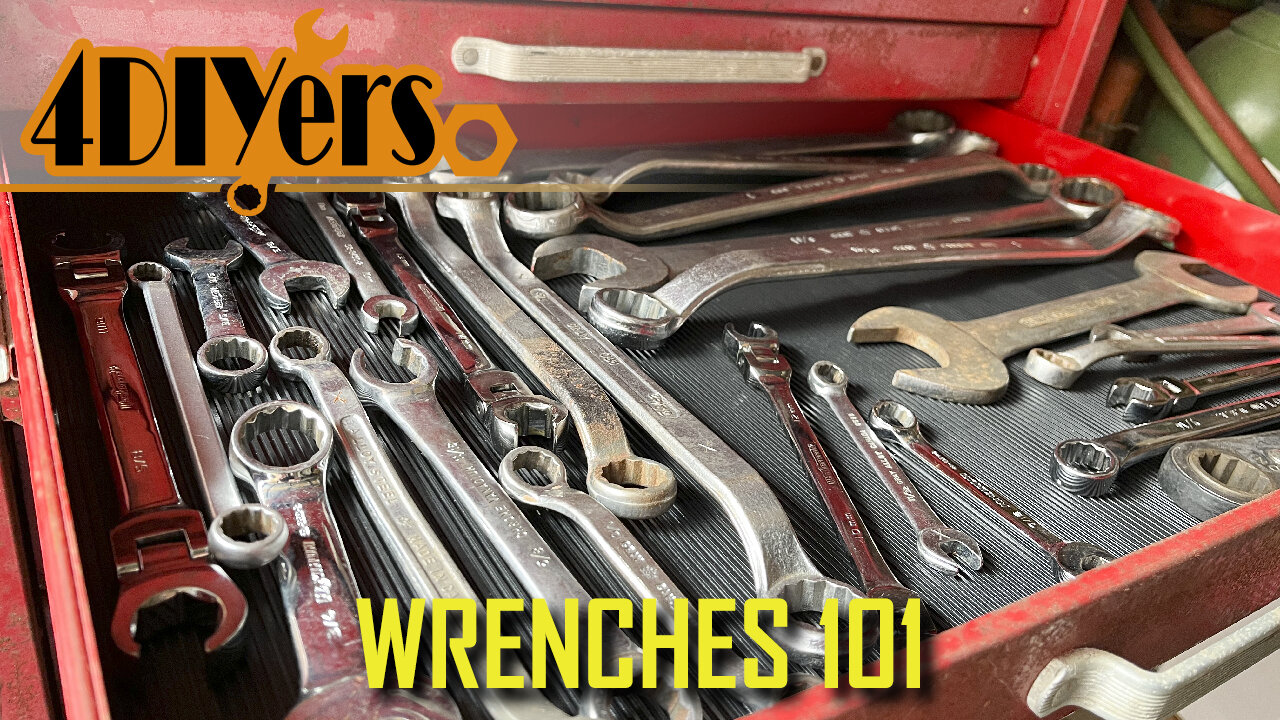Premium Only Content

Wrenches 101: Here's What you Need to Know
Everything you need to know about wrenches. What the most common wrenches are used in automotive repairs, along with their benefits, some comparisons and some tips. #tooltech #OEMTools #mechanic
OEMTOOLS 22217 40 Wrench Magnetic Organizing Rails: https://www.mobiledistributorsupply.com/22217-oemtools-22217-40-wrench-magnetic-organizing-rails-oem
Website: http://4diyers.com
Patreon: https://www.patreon.com/4diyers
Facebook: https://www.facebook.com/4diyers
Twitter: https://twitter.com/4DIYers
Instagram: https://www.instagram.com/4diyers/
Tumblr: http://4diyers.tumblr.com
Pintrest: https://www.pinterest.com/4diyers/
Chapters:
00:00 Intro
00:17 Combination Wrench
01:07 Open End Wrench
01:28 Box End Wrench
01:52 Line Wrench
02:32 Ratcheting Wrench
03:04 Crowfoot Wrenches
03:45 Specialty Wrenches
05:01 Open VS Box Ends
05:34 Interchangeable Sizes
06:47 Wrench Care & Storage
Combination wrench: this has both an open end and box end. The open and box ends are both the same size. The box end is available in both a 6 and 12 point versions. I’ll use these sockets as an example as I don’t have a 6 point wrench. A 6 point is a single hexagon, it has 6 vertices. These are great for maximum contact surface on a fastener, this means it’s able to handle more pressure reducing the chance of stripped that nut or bolt. A 12 point on the other hand, this is a double hexagon, it has vertices. A 12 point works great if you have a tight area with minimal movement for the wrench or if you’re working with a 12 point fastener. The downfall is that there’s a higher chance of stripped a fastener with a 12 point.
Open ended wrench: this is a wrench has two open ends. Each side will be a different size, one this large wrench the one side is 30mm and the other is 32mm. The main benefit is that you don’t need to carry as many wrenches and they can slip in from the side on a fastener.
Boxed end wrench: both sides are boxed, available is 6 and 12 point versions. Each end is a different size just like the open end wrench. These too allow one to cut back on the amount of tools they need to carry or store, they provide a better grip on fasteners but they are required to go over top of a fastener which may not be ideal in all situations.
Line wrench: just like the previous two styles of wrenches, these those are the same style on each end but will be a different size cutting back the need for more wrenches. They’re like a boxed end but with a cutout to fit over top of hydraulic, brake, or fuel lines. You’ll notice that they’re a 6 point to maximum surface contact on a fitting and they have a thicker profile to reduce the chance of the hex opening up. They simply fit over a line, this can be anything from a hydraulic, oil, fuel, air, or brake line.
If you were to use an open end on a fitting, there is a much higher chance of stripped the hex as it only has contact on two surfaces.
Ratcheting wrenches: they’re not a must have if you’re working on cars as a past time, but they do make life easier and are especially useful in a professional field to save time. However the biggest downfall is the cost as they can be quite expensive and they have moving components which could potentially fail or wear out. They’re great for working in tight places, they do have a slightly thicker profile on the box end, and the direction of movement is easily changed by flipping over the wrench.
Crowfoot wrench: an attachment rather than a tool that can be used by itself like a traditional wrench. It consists of an open end, this connects to a ratchet for working in awkward or tight spaces. This is another style which I rarely use, but you’ll definitely know when you’re in need of one. Before I had these, I ended up making my own and this was for the knock sensors on a BMW M62 V8. If these are being used with a torque wrench, if the crowfoot is perpendicular to the pivot point such as this, you’ll be applying the correct torque value to what your torque wrench is set as. But if the crowfoot is lower or higher than the pivot point such as this, a calculation is required to make adjustments to the required torque value.
Striking wrenches: as the name implies, those can be hit with a hammer to shock a fastener for loosening or tightening. Specialty wrenches aren’t typically needed for those of us working at home on our own projects, they tend to be more oriented to those working in the field.
Thank you to all those who watch my videos and support my content. Don't forget to subscribe to my channel for future tutorial videos and like my video if you found it helpful. New videos are always being uploaded every week!
© 4DIYers 2013
All Rights Reserved
No part of this video or any of its contents may be reproduced, copied, modified or adapted, without the prior written consent of the author.
-
 6:00:08
6:00:08
SpartakusLIVE
8 hours agoYoung Spartan STUD teams with old gamers for ultimate BANTER with a SMATTERING of TOXICITY
28.1K -
 1:50:39
1:50:39
Kim Iversen
10 hours agoShocking Proposal: Elon Musk for Speaker of the House?! | IDF Soldiers Reveal Atrocities—'Everyone Is a Terrorist'
73.9K162 -
 43:27
43:27
barstoolsports
13 hours agoOld Dog Bites Back | Surviving Barstool S4 Ep. 9
125K3 -
 5:13:04
5:13:04
Right Side Broadcasting Network
7 days agoLIVE REPLAY: TPUSA's America Fest Conference: Day One - 12/19/24
178K28 -
 1:06:01
1:06:01
Man in America
1 day agoPfizer Has Been Caught RED HANDED w/ Dr. Chris Flowers
59.8K15 -
 2:24:15
2:24:15
Slightly Offensive
11 hours ago $17.12 earnedAttempted ASSASSINATION of Nick J Fuentes LEAVES 1 DEAD! | Guest: Mel K & Breanna Morello
47.4K43 -
 1:43:08
1:43:08
Roseanne Barr
10 hours ago $28.29 earned"Ain't Nobody Good" with Jesse Lee Peterson | The Roseanne Barr Podcast #79
83.7K49 -

The StoneZONE with Roger Stone
7 hours agoTrump Should Sue Billionaire Governor JB Pritzker for Calling Him a Rapist | The StoneZONE
51.6K5 -
 1:36:58
1:36:58
Flyover Conservatives
1 day agoAmerica’s Psychiatrist Speaks Out: Are We Greenlighting Violence? - Dr. Carole Lieberman | FOC Show
34.9K6 -
 6:44:54
6:44:54
LittleSaltyBear
9 hours ago $3.20 earnedNecromancing Path of Exile 2 4K
30.5K4